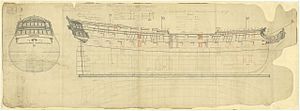HMS Powerful (1783) facts for kids

Plan of Powerful
|
|
Quick facts for kids History |
|
|---|---|
| Name | HMS Powerful |
| Ordered | 8 July 1780 |
| Builder | Perry, Blackwall Yard |
| Laid down | April 1781 |
| Launched | 3 April 1783 |
| Commissioned | 22 April 1783 |
| Decommissioned | October 1809 |
| Fate | Broken up, 1812 |
| General characteristics | |
| Class and type | Elizabeth-class ship of the line |
| Tons burthen | 1627 (bm) |
| Length | 168 ft 6 in (51.36 m) (gundeck) |
| Beam | 46 ft (14 m) |
| Depth of hold | 19 ft 9 in (6.02 m) |
| Propulsion | Sails |
| Sail plan | Full-rigged ship |
| Armament |
|
HMS Powerful was a large warship called a ship of the line in the Royal Navy. It had 74 guns and was known as a "third-rate" ship. Powerful was part of many important events. It helped defeat a Dutch fleet at the Battle of Camperdown in 1797. The ship also captured a French privateer in 1806. Later, it took part in operations against the Dutch in the East Indies. Finally, it served in the Walcheren Campaign in 1809.
Contents
Life of a Powerful Ship: Its Career
Powerful was built in London at Blackwall Yard. It was launched on April 3, 1783. The ship officially started service on April 22, 1783. It served until July 1, 1788.
In 1785, an American named John Lyddiard was part of its crew. He had been forced to join the Royal Navy during the American Revolutionary War. Lyddiard wrote to the American ambassador, John Adams, asking for help. The British government then ordered his release.
Early Missions and Captures
After some repairs, Powerful returned to service in 1790. In April 1793, a war started between France and England. Powerful, led by Captain Thomas Hicks, joined a group of ships. Their job was to protect merchant ships traveling to Cape Finisterre.
Later, two other ships in the group captured a French privateer. A privateer was a private ship allowed to attack enemy ships. This privateer had also captured a Spanish ship called St. Jago. The St. Jago was full of treasure! It carried silver coins, gold bars, jewels, and other valuable goods. The treasure was sent to the Tower of London.
Powerful and another ship were not involved in capturing St. Jago. So, they did not get any of the treasure money. However, Powerful's crew later received money for capturing other ships. These included a French merchant ship and a British ship that had been captured by the enemy.
Joining the North Sea Fleet
In August 1795, Captain William O'Bryen Drury took command of Powerful. The ship joined the North Sea Fleet. This fleet was led by Admiral Adam Duncan.
Powerful helped another ship, HMS Phoenix, take prisoners from a captured Dutch ship. Powerful also received money for helping capture a French privateer named Franklyn in 1796.

Battle of Camperdown (1797)
On October 11, 1797, Powerful fought in the Battle of Camperdown. This was a big battle where Admiral Duncan's fleet defeated the Dutch. Powerful was the second ship in its line. It followed HMS Monarch in breaking through the enemy's battle line. The ship was heavily involved in the fighting.
After the battle, Powerful reported 88 casualties. This included 10 sailors and marines who were killed. Four officers and 74 other sailors and marines were wounded. Powerful later received a share of the prize money for the captured Dutch ships.
Mediterranean and Baltic Service
In 1798, Powerful joined a group of ships in the Mediterranean Sea. They operated near Cadiz, Spain. The ship earned prize money for helping capture many enemy ships between February and October 1798.
From 1800, Powerful served in different areas. These included the Baltic Sea, the Mediterranean, and the West Indies. Captain Sir Francis Laforey was in command during this time. The ship received prize money for capturing several ships in the Baltic Sea in 1801.
Captain Robert Plampin took command of Powerful in August 1805.
East Indies Operations (1806-1807)
Powerful arrived too late to fight in the Battle of Trafalgar in November 1805. It was then sent to join the East India squadron. This group of ships was led by Rear Admiral Edward Pellew.
On June 13, 1806, Powerful captured a French privateer named Henriette. This happened off Trincomalee, Sri Lanka. Powerful had heard about the privateer and set out to find it. After an 11-hour chase, Powerful caught up. Henriette surrendered without a fight. During the chase, Henriette's crew had thrown some of their guns overboard to try and go faster.
Later, on July 9, 1806, Powerful helped capture another French privateer called Bellone. Bellone had been causing a lot of trouble for British trade ships. Powerful pretended to be a merchant ship to trick Bellone.
Powerful also took part in Admiral Pellew's attack on Batavia (now Jakarta) on November 27, 1806. It then participated in the attack on Griessie in December 1807. These actions greatly weakened the Dutch navy in the Pacific Ocean.
Final Service and Fate
In 1808, Powerful returned to England. Captain Charles James Johnston was in command. Even though the ship was in poor condition, it was used in the Walcheren Campaign. This was a British military operation in the Netherlands.
Powerful was finally taken out of service in October 1809. It was broken up for parts in 1812.
Images for kids


